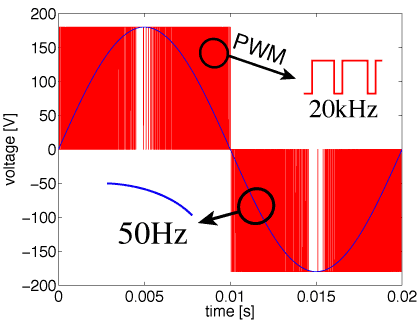Multirate

Highly integrated electric cicuits show a phenomenon called latency. That is, a processed signal causes activity only in a small subset of the whole circuit (imagine a central processing unit), whereas the other part of the system behaves almost constant over some time - is latent. Such an electric system can be described as coupled system, where the waveforms show different time scales, also refered to as multirate.
More generally, any coupled problem formulation due to coupled physical effects, may cause a multirate problem: image the simulation of car driving on the road, there you need a model for the wheel, the chassis, the dampers, the road,... (cf. co-simulation). Again each system is covered by their own time constant, which might vary over several orders of magnitude comparing different subsystems.
Classical methods cannot exploit this multirate potential, but resolve everything on the finest scale. This causes an over sampling of the latent components. In constrast, Co-simulation or especially dedicated multirate methods are designed to use the inherent step size to resolve the time-domain behaviour of each subystem with the required accuracy. This requires a time-stepping for each.
Group members working in that field
- Andreas Bartel
- Michael Günther
Former and ongoing Projects
- CoMSON
- ICESTARS
- 03GUNAVN
Cooperations
- Herbert de Gersem, K.U. Leuven, Belgium
- Jan ter Maten, TU Eindhoven and NXP, the Netherlands
Publications
- 1991
366.
Becker, Eilhard; Benter, Thorsten; Kampf, R.; Schindler, Ralph N.; Wille, Uta
A Redetermination of the Rate Constant of the Reaction F + HNO\(_{3}\) → HF + NO\(_{3}\)
Berichte der Bunsengesellschaft für physikalische Chemie, 95 (10) :1168-1173
1991365.
Becker, Eilhard; Benter, Thorsten; Kampf, R.; Schindler, Ralph N.; Wille, Uta
A Redetermination of the Rate Constant of the Reaction F + HNO3 → HF + NO3
Berichte der Bunsengesellschaft für physikalische Chemie, 95 (10) :1168-1173
1991364.
Jensen, Per; Bunker, Philip R.; Karpfen, Alfred
An ab initio calculation of the nonadiabatic effect on the tunneling splitting in vibrationally excited (HF)\(_{2}\)
Journal of Molecular Spectroscopy, 148 (2) :385-390
1991363.
Jensen, Per; Bunker, Philip R.; Karpfen, Alfred
An ab initio calculation of the nonadiabatic effect on the tunneling splitting in vibrationally excited (HF)\(_{2}\)
Journal of Molecular Spectroscopy, 148 (2) :385-390
1991362.
Jensen, Per; Bunker, Philip R.; Karpfen, Alfred
An ab initio calculation of the nonadiabatic effect on the tunneling splitting in vibrationally excited (HF)2
Journal of Molecular Spectroscopy, 148 (2) :385-390
1991361.
Jensen, Per; Marshall, Mark D.; Bunker, Philip R.; Karpfen, Alfred
An ab initio close-coupling calculation of the lower vibrational energies of the HCl dimer
Chemical Physics Letters, 180 (6) :594-600
1991360.
Jensen, Per; Marshall, Mark D.; Bunker, Philip R.; Karpfen, Alfred
An ab initio close-coupling calculation of the lower vibrational energies of the HCl dimer
Chemical Physics Letters, 180 (6) :594-600
1991359.
Jensen, Per; Marshall, Mark D.; Bunker, Philip R.; Karpfen, Alfred
An ab initio close-coupling calculation of the lower vibrational energies of the HCl dimer
Chemical Physics Letters, 180 (6) :594-600
1991358.
Marshall, Mark D.; Jensen, Per; Bunker, Philip R.
An ab initio close-coupling calculation of the lower vibrational energies of the HF dimer
Chemical Physics Letters, 176 (3-4) :255-260
1991357.
Marshall, Mark D.; Jensen, Per; Bunker, Philip R.
An ab initio close-coupling calculation of the lower vibrational energies of the HF dimer
Chemical Physics Letters, 176 (3-4) :255-260
1991356.
Marshall, Mark D.; Jensen, Per; Bunker, Philip R.
An ab initio close-coupling calculation of the lower vibrational energies of the HF dimer
Chemical Physics Letters, 176 (3-4) :255-260
1991355.
Karpfen, Alfred; Bunker, Philip R.; Jensen, Per
An ab initio study of the hydrogen chloride dimer: the potential energy surface and the characterization of the stationary points
Chemical Physics, 149 (3) :299-309
1991354.
Karpfen, Alfred; Bunker, Philip R.; Jensen, Per
An ab initio study of the hydrogen chloride dimer: the potential energy surface and the characterization of the stationary points
Chemical Physics, 149 (3) :299-309
1991353.
Karpfen, Alfred; Bunker, Philip R.; Jensen, Per
An ab initio study of the hydrogen chloride dimer: the potential energy surface and the characterization of the stationary points
Chemical Physics, 149 (3) :299-309
1991352.
Bunker, Philip R.; Epa, V. C.; Jensen, Per; Karpfen, Alfred
An analytical ab initio potential surface and the calculated tunneling energies for the HCl dimer
Journal of Molecular Spectroscopy, 146 (1) :200-219
1991351.
Bunker, Philip R.; Epa, V. C.; Jensen, Per; Karpfen, Alfred
An analytical ab initio potential surface and the calculated tunneling energies for the HCl dimer
Journal of Molecular Spectroscopy, 146 (1) :200-219
1991350.
Bunker, Philip R.; Epa, V. C.; Jensen, Per; Karpfen, Alfred
An analytical ab initio potential surface and the calculated tunneling energies for the HCl dimer
Journal of Molecular Spectroscopy, 146 (1) :200-219
1991349.
Fink, Ewald H.; Setzer, Klaus-Dieter; Wildt, J{ü}rgen; Ramsay, D. A.; Vervloet, M.
Collision-induced emission of O\(_{2}\)(b\(^{1}\)\(\Sigma\)\(_{g}\)\(^{+}\) → a\(^{1}\)\(\Delta\)\(_{g}\)) in the gas phase
International Journal of Quantum Chemistry, 39 (3) :287-298
1991348.
Fink, Ewald H.; Setzer, Klaus-Dieter; Wildt, J{ü}rgen; Ramsay, D. A.; Vervloet, M.
Collision-induced emission of O\(_{2}\)(b\(^{1}\)\(\Sigma\)\(_{g}\)\(^{+}\) → a\(^{1}\)\(\Delta\)\(_{g}\)) in the gas phase
International Journal of Quantum Chemistry, 39 (3) :287-298
1991347.
Fink, Ewald H.; Setzer, Klaus-Dieter; Wildt, Jürgen; Ramsay, D. A.; Vervloet, M.
Collision-induced emission of O2(b1Σg+ → a1Δg) in the gas phase
International Journal of Quantum Chemistry, 39 (3) :287-298
1991346.
Vilesov, A. F.; Wildt, J{ü}rgen; Fink, Ewald H.
Emission of Xe: N(\(^{2}\)P) collision complexes near the N(\(^{2}\)P→\(^{2}\)D) lines
Chemical Physics, 153 (3) :531-537
1991345.
Vilesov, A. F.; Wildt, J{ü}rgen; Fink, Ewald H.
Emission of Xe: N(\(^{2}\)P) collision complexes near the N(\(^{2}\)P→\(^{2}\)D) lines
Chemical Physics, 153 (3) :531-537
1991344.
Vilesov, A. F.; Wildt, Jürgen; Fink, Ewald H.
Emission of Xe: N(2P) collision complexes near the N(2P→2D) lines
Chemical Physics, 153 (3) :531-537
1991343.
Heilmann, Margareta; Müller, Manfred
Equivalence of a weighted modulus of smoothness and a modified weighted K-functional
In Nevai, P. and Pinkus, A., Editor
Publisher: Academic Press
1991342.
Jensen, Per; Oddershede, Jens; Sabin, John R.
Geometric dependence of the mean excitation energy and spectral moments of water
Physical Review A, 43 (7) :4040-4043
1991
